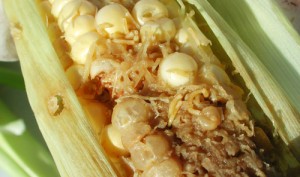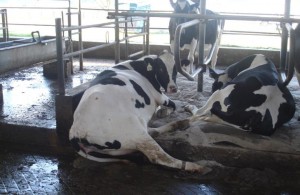
EDIS is the University of Florida’s Official website with fact sheets available to download on a wide variety of topics for free.
The University of Florida database of fact sheets called EDIS (Electronic Data Information Source) has many publications of interest to farmers and ranchers in Northwest Florida. http://edis.ifas.ufl.edu Each fact sheet has a PDF or printer friendly link in the top left corner. The following are just a few of the new fact sheets that have been recently added to the collection.
Crops
Cornsilk Fly (suggested common name), Euxesta stigmatias Loew (Insecta: Diptera: Otitidae) (EENY224/IN381)
‘Cornsilk flies’ are attractive, medium to dark metall ic green to black colored flies with distinctive wing patterns and wing flapping behavior. They are commonly found throughout Florida’s agricultural communities. The larvae can be destructive in nature when it comes to their preference for sweet corn ears. Four species of ‘cornsilk flies’ are known to attack corn in Florida: Chaetopsis massyla (Walker), Euxesta annonae (Fabricius), Euxesta eluta Loew, and Euxesta stigmatias Loew. This 8-page fact sheet was written by Gregg S. Nuessly and John L. Capinera, and published by the UF Department of Entomology and Nematology, April 2013.
ic green to black colored flies with distinctive wing patterns and wing flapping behavior. They are commonly found throughout Florida’s agricultural communities. The larvae can be destructive in nature when it comes to their preference for sweet corn ears. Four species of ‘cornsilk flies’ are known to attack corn in Florida: Chaetopsis massyla (Walker), Euxesta annonae (Fabricius), Euxesta eluta Loew, and Euxesta stigmatias Loew. This 8-page fact sheet was written by Gregg S. Nuessly and John L. Capinera, and published by the UF Department of Entomology and Nematology, April 2013.
http://edis.ifas.ufl.edu/pdffiles/IN/IN38100.pdf
Livestock
 Cattle Grub Management (ENY290/IN979)
Cattle Grub Management (ENY290/IN979)
Immature warble flies, or cattle grubs, infest and harm livestock throughout the world. Warble flies also are known as “heel flies” because they cause cattle to kick at themselves, and “gad flies” because they cause cattle to “gad about” in an attempt to evade the flies. Two species of cattle grubs occur in the U.S.A., the common cattle grub, and the northern cattle grub. This 6-page fact sheet was written by P. E. Kaufman and E. N. I. Weeks, and published by the UF Department of Entomology and Nematology, March 2013. http://edis.ifas.ufl.edu/pdffiles/IN/IN97900.pdf
Comparing Waterbeds and Sand Beds for Cows at the UF/IFAS Dairy Unit (VM194)
 One important aspect of a cow’s comfort is the type of bedding used. Waterbeds for cows have recently gained popularity because of advertisements, news reports in outlets such as CNN. The UF/IFAS Dairy Unit (DU) provides a good opportunity to compare sand beds and waterbeds at optimal conditions. The dairy has waterbeds installed in one half of the barns and sand beds in the other half. This publication provides a field comparison of waterbeds and sand beds in one herd. We observed that when stalls are maintained at optimal conditions, cows in sand-bedded stalls had decreased incidence of hock lesions and increased stall usage compared to cows in waterbeds. This 5-page fact sheet was written by Klibs N. Galvão and Ori Eizenberg, and published by the UF Department of Veterinary Medicine-Large Animal Clinical Sciences, May 2013. http://edis.ifas.ufl.edu/pdffiles/VM/VM19400.pdf
One important aspect of a cow’s comfort is the type of bedding used. Waterbeds for cows have recently gained popularity because of advertisements, news reports in outlets such as CNN. The UF/IFAS Dairy Unit (DU) provides a good opportunity to compare sand beds and waterbeds at optimal conditions. The dairy has waterbeds installed in one half of the barns and sand beds in the other half. This publication provides a field comparison of waterbeds and sand beds in one herd. We observed that when stalls are maintained at optimal conditions, cows in sand-bedded stalls had decreased incidence of hock lesions and increased stall usage compared to cows in waterbeds. This 5-page fact sheet was written by Klibs N. Galvão and Ori Eizenberg, and published by the UF Department of Veterinary Medicine-Large Animal Clinical Sciences, May 2013. http://edis.ifas.ufl.edu/pdffiles/VM/VM19400.pdf
Pest Management
Calibration of Chemical Applicators Used in Vegetables (HS1220)
 Calibration is the process used to determine the amount of chemical material applied per unit area. Equipment for applying liquid and dry materials must be accurately calibrated for pesticides to work efficiently and to avoid crop injury or death. The pesticide label is a legal document and must be followed. Properly calibrating equipment ensures the product is being applied as specified on the label and that environmental contamination will be minimized. This 6-page fact sheet discusses some methods for calibration of sprayers and dry material spreaders and includes information about calibration to help growers properly apply pesticides. written by M. R. Miller and P. J. Dittmar, and published by the UF Department of Horticultural Sciences, May 2013. http://edis.ifas.ufl.edu/pdffiles/HS/HS122000.pdf
Calibration is the process used to determine the amount of chemical material applied per unit area. Equipment for applying liquid and dry materials must be accurately calibrated for pesticides to work efficiently and to avoid crop injury or death. The pesticide label is a legal document and must be followed. Properly calibrating equipment ensures the product is being applied as specified on the label and that environmental contamination will be minimized. This 6-page fact sheet discusses some methods for calibration of sprayers and dry material spreaders and includes information about calibration to help growers properly apply pesticides. written by M. R. Miller and P. J. Dittmar, and published by the UF Department of Horticultural Sciences, May 2013. http://edis.ifas.ufl.edu/pdffiles/HS/HS122000.pdf
Pest Management Perceptions and Practices for Equine Farms in North and Central Florida (ENY2028/IN983)
 Equine facilities have unique pest management problems due to facility structure and horse husbandry practices. In Florida, homes on small equine farms are generally located in close proximity to pastures, stalls or run-in sheds, manure piles, and other fly breeding habitats. So homeowners have a high risk of exposure to pathogens that can be transmitted by filth flies to humans. Integrated pest management for equine farms requires accurate diagnosis of pest problems and the coordinated use of science-based management practices, but a recent survey shows that many equine property owners don’t know enough about the identification, biology, and presence of filth fly pests on their properties to develop successful IPM programs. This 7-page fact sheet was written by Erika T. Machtinger, Norman C. Leppla, and Cindy Saunders, and published by the UF Department of Entomology and Nematology, March 2013. http://edis.ifas.ufl.edu/pdffiles/IN/IN98300.pdf
Equine facilities have unique pest management problems due to facility structure and horse husbandry practices. In Florida, homes on small equine farms are generally located in close proximity to pastures, stalls or run-in sheds, manure piles, and other fly breeding habitats. So homeowners have a high risk of exposure to pathogens that can be transmitted by filth flies to humans. Integrated pest management for equine farms requires accurate diagnosis of pest problems and the coordinated use of science-based management practices, but a recent survey shows that many equine property owners don’t know enough about the identification, biology, and presence of filth fly pests on their properties to develop successful IPM programs. This 7-page fact sheet was written by Erika T. Machtinger, Norman C. Leppla, and Cindy Saunders, and published by the UF Department of Entomology and Nematology, March 2013. http://edis.ifas.ufl.edu/pdffiles/IN/IN98300.pdf
The Importance of Keeping Pesticide Records (PI246)
Keeping accurate records of pesticide use makes good sense. In some cases, you are required by law to maintain records on pesticide use, but having records available can also help you improve your operation. This 8-page fact sheet outlines who is required to keep records of pesticide use and the appropriate contents. Written by F. M. Fishel, and published by the UF Department of Agronomy, May 2013. http://edis.ifas.ufl.edu/pdffiles/PI/PI24600.pdf
- November 2025 Weather Summary & Winter Outlook - December 5, 2025
- Friday Feature: The History of Beekeeping - December 5, 2025
- Friday Feature:Malone Pecan Festival Tractorcade - November 21, 2025
